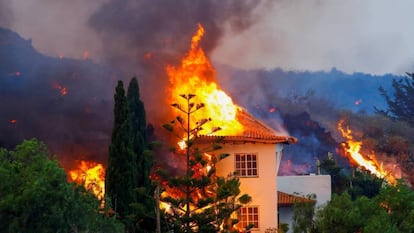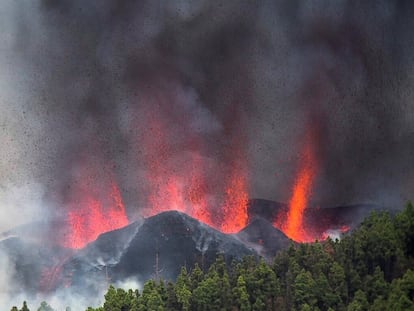Lava flow from volcano on La Palma measures an average of six meters high
The president of the island council, Mariano Hernández Zapata, called the scene ‘devastating’ given that the molten rock ‘is literally eating up the houses, infrastructure and crops’ on in its path toward the coast

The volcano on La Palma, the first that has erupted in Spain since 1971, has the island on tenterhooks a day after it started to shoot out fire, smoke and ash. Up until now, the fissures that opened up yesterday in the Montaña Rajada mountains in the municipality of El Paso have emitted a lava flow measuring an average of six meters high, and that was moving at a speed of around 300 meters per hour on Monday afternoon, slower than the 700 meters an hour initially estimated as the lava first left the volcano. It was destroying everything it touched through localities such as Tacande and El Paraíso. La Palma is part of Spain’s Canary Islands, a volcanic archipelago located off the northwestern coast of Africa.
So far, the eruption of the volcano has not claimed any victims, but around 5,000 people were forced to evacuate their homes last night. The scene in the area, however, has been described as “devastating” by the president of the island council, Mariano Hernández Zapata, given that the lava “is literally eating up the houses, infrastructure and crops that it is finding on its path toward the coast in the valley of Aridane.”
Speaking at a press conference on Monday, Spanish Prime Minister Pedro Sánchez of the Socialist Party (PSOE) said that “the whole of Spain is with La Palma.” He was speaking alongside his interior minister, Fernando Grande-Marlaska. The two politicians had traveled to La Palma to oversee the management of the crisis. “This eruption will not see anyone left behind, or damaged from a financial point of view,” Sánchez continued. He stated that “all of the resources of the state” will be made available for the residents of La Palma.
The regional premier of the Canary Islands, Ángel Víctor Torres, also appeared at the press conference with Sánchez and Grande-Marlaska. He explained that the lava flow is likely to continue moving toward the sea over the course of Monday, and that the volcano had already emitted more than 20,000 tons of sulfur dioxide. A lack of windy weather meant that the activity at the airport on the island was able to continue without interruption on Monday.

One of the houses that was destroyed by the lava flow was that of Alberto, a man in his forties who lives in El Paraíso. On Monday, he was watching the natural phenomenon sitting on the edge of the LP3 road, in Tajuya. He had nervously awaited news of his property last night. “Yesterday I was unsure, but today they confirmed that the lava has swallowed up my house,” he said with a faltering voice. “This is a catastrophe.”
Gerhard Beck and his wife ended up at a military camp after a night of being constantly moved from one place to another. “We don’t know what happened to our house, but we fear the worst,” he explained. “We are going to a hotel for two days now. They have treated us well, but we’ve been very scared, really scared.”
They were among the 5,000 people who were evacuated from their homes yesterday, and along with 300 other people spent the night at the El Fuerte barracks on the outskirts of the island capital, Santa Cruz de la Palma.
King Felipe VI conveyed his “encouragement” to the inhabitants of La Palma in the wake of the eruption of the Cumbre Vieja volcano, also known as Cabeza de Vaca. He added that he was watching closely and with concern the progress of events and was in constant contact with the government and the local authorities.
During its slow progress, the lava swallowed up around a hundred homes, according to local authorities. But, as explained by Carlos Rodríguez, an electrical engineer from power company Endesa, it avoided others. “My mother-in-law’s property escaped,” he said. “The lava solidified two or three meters from the wall and we were just saved in the nick of time. I can’t understand how we managed to escape.”
Military emergency unit
The National Police deployed 92 officers on Monday, while four helicopters were constantly monitoring the area from above. A total of 200 Civil Guard officers were taking part in the operations, while the UME military emergency unit deployed 67 members and 30 vehicles on La Palma. The latter force is due to be strengthened until it measures 180 personnel and 57 vehicles.
The seven eruptions that La Palma had seen until Sunday were all in the area of Cumbre Vieja, and their duration lasted between one and three months. The longest eruption documented on the so-called “isla bonita” was at Tehuya, and took place in 1586. It lasted 84 days. The shortest, meanwhile, was at Teneguía, in 1971, lasting 24 days.
Residents of the island remained tense on Monday as the lava flow progressed. “We were in the street at the bus stop and suddenly we heard the volcano explode,” explained Xiomara and Alexandra, aged 15 and 16, and who also spent the night at El Fuerte. “My dad called me,” Alexandra explained. “We grabbed the chihuahua and a parrot and we went to the soccer field at Los Llanos.” Later they went to a shelter in neighboring El Paso, before ending up at the barracks. “Our houses have been saved, but two of our friends lost theirs in Tacande,” they complained. “We are very scared for them.”
English version by Simon Hunter.
Tu suscripción se está usando en otro dispositivo
¿Quieres añadir otro usuario a tu suscripción?
Si continúas leyendo en este dispositivo, no se podrá leer en el otro.
FlechaTu suscripción se está usando en otro dispositivo y solo puedes acceder a EL PAÍS desde un dispositivo a la vez.
Si quieres compartir tu cuenta, cambia tu suscripción a la modalidad Premium, así podrás añadir otro usuario. Cada uno accederá con su propia cuenta de email, lo que os permitirá personalizar vuestra experiencia en EL PAÍS.
¿Tienes una suscripción de empresa? Accede aquí para contratar más cuentas.
En el caso de no saber quién está usando tu cuenta, te recomendamos cambiar tu contraseña aquí.
Si decides continuar compartiendo tu cuenta, este mensaje se mostrará en tu dispositivo y en el de la otra persona que está usando tu cuenta de forma indefinida, afectando a tu experiencia de lectura. Puedes consultar aquí los términos y condiciones de la suscripción digital.
More information
Últimas noticias
Alain Aspect, Nobel laureate in physics: ‘Einstein was so smart that he would have had to recognize quantum entanglement’
Imelda Castro, the woman who wants to rule the cartel battleground of Sinaloa
The new victims of the Republican war on Obamacare: Millions hit by soaring health insurance premiums
A country divided on migrant rights: Some US states expand protections while others restrict them
Most viewed
- David King, chemist: ‘There are scientists studying how to cool the planet; nobody should stop these experiments from happening’
- Reinhard Genzel, Nobel laureate in physics: ‘One-minute videos will never give you the truth’
- Oona Chaplin: ‘I told James Cameron that I was living in a treehouse and starting a permaculture project with a friend’
- Sinaloa Cartel war is taking its toll on Los Chapitos
- Mexico completes its trade shift with the entry into force of tariffs on China and countries without trade agreements











































